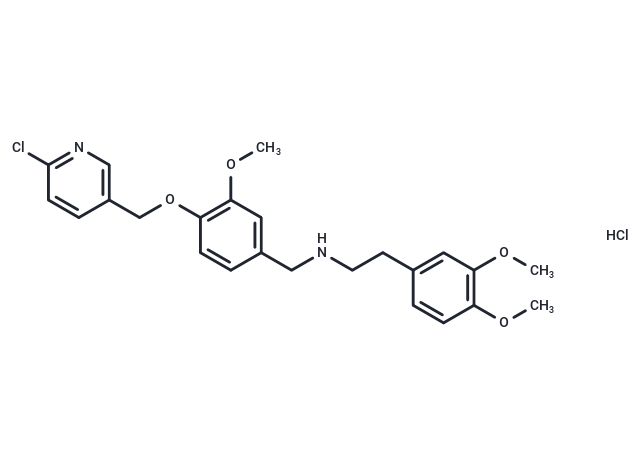Shopping Cart
- Remove All
 Your shopping cart is currently empty
Your shopping cart is currently empty

SBE13 Hydrochloride (SBE 13 HCl) is an effective and specific PLK1 inhibitor (IC50: 0.2 nM); no inhibition om Aurora A kinase, Plk2/3.

| Pack Size | Price | Availability | Quantity |
|---|---|---|---|
| 5 mg | $29 | In Stock | |
| 10 mg | $47 | In Stock | |
| 25 mg | $94 | In Stock | |
| 50 mg | $178 | In Stock | |
| 100 mg | $266 | In Stock | |
| 200 mg | $383 | In Stock | |
| 1 mL x 10 mM (in DMSO) | $32 | In Stock |
| Description | SBE13 Hydrochloride (SBE 13 HCl) is an effective and specific PLK1 inhibitor (IC50: 0.2 nM); no inhibition om Aurora A kinase, Plk2/3. |
| Targets&IC50 | PLK1:0.2 nM |
| In vivo | SBE 13 does not impair the cell cycle or proliferation of primary cells, yet it diminishes the proliferation of various cancer cell lines, induces G2/M arrest, and promotes apoptosis. Co-administration of SBE 13 with Enzastaurin synergistically reduces cell proliferation and enhances apoptosis induction in HCT116 (p53-/-) cells. |
| Kinase Assay | Kinase assays: To assay Plk1 and Aurora A kinase activity, cells are lysed after 13 hrs release in the presence of SBE13 after double thymidine block, and kinases are immunoprecipitated from lysates using antibodies as described. In brief, for each immunoprecipitation 800 μg of total protein were incubated with 1.5 μg Plk1 antibody cocktail, 3 μg Plk2 antibody, 3 μg Plk3 antibody, or 5 μg Aurora A antibody, respectively, for 2 hrs at 4°C on a rotator. Immunoprecipitated protein is collected using Protein G Agarose beads. The Plk1, Plk2 and Plk3 immunoprecipitates are incubated with 1 μg casein and with 1 μCi of [γ32-P]ATP for 30 min at 37°C in kinase buffer. The Aurora A immunoprecipitates are incubated with 0.5 μl Histone and with 1 μCi of [γ32-P]ATP for 60 min at room temperature in kinase buffer. Products from the kinase assays are fractionated on 10% Bis-Tris-polyacrylamide gels, and the phosphorylated substrate is visualized by autoradiography after an exposure of 12 to 36 hrs. An equal amount of immunoprecipitates is subjected to western blot analysis to confirm equal loading of Plk1, Plk2, Plk3 or Aurora A protein in kinase reactions. Immunoprecipitated Plk1 after 13 hrs release in the presence of SBE13 is assayed after de-phosphorylation using λ protein phosphatase and compared to kinase activity of endogenous immunoprecipitated Plk1. Activity of Plk1 kinase with and wiiiuithout de-phosphorylation is compared and the ratio between de-phosphorylated and "normal" endogenous immunoprecipitated Plk1 kinase activity is calculated. |
| Cell Research | Cells are treated with SBE13 one day after subculturing. Control cells are incubated with normal culture medium. Concentrations of SBE13 ranged from 1 nM–100 μM. The growth rate of 1 x 105 cells per 6-well is determined by counting cells at 24, 48 and 72 hours after treatment. Cell culture studies are performed in triplicate for each time point.(Only for Reference) |
| Alias | SBE 13 hydrochloride, SBE 13 HCl |
| Molecular Weight | 479.4 |
| Formula | C24H28Cl2N2O4 |
| Cas No. | 1052532-15-6 |
| Smiles | Clc1ncc(COc2c(OC)cc(CNCCc3cc(OC)c(OC)cc3)cc2)cc1.Cl |
| Relative Density. | no data available |
| Storage | Powder: -20°C for 3 years | In solvent: -80°C for 1 year | Shipping with blue ice. | ||||||||||||||||||||||||||||||||||||||||
| Solubility Information | H2O: 4.8 mg/mL (10 mM)), Heating is recommended. DMSO: 80 mg/mL (166.88 mM), Sonication is recommended. | ||||||||||||||||||||||||||||||||||||||||
Solution Preparation Table | |||||||||||||||||||||||||||||||||||||||||
H2O/DMSO
DMSO
| |||||||||||||||||||||||||||||||||||||||||

Copyright © 2015-2025 TargetMol Chemicals Inc. All Rights Reserved.